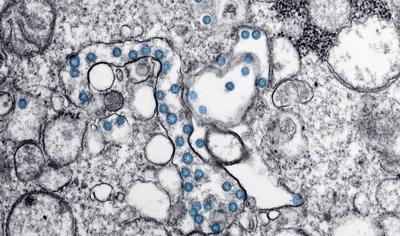
Transmission electron microscopic image of an isolate from the first U.S. case of COVID-19. The spherical viral particles, colorized blue, contain cross-sections through the viral genome, seen as black dots.
ST. LOUIS — A team of researchers at Washington University has developed an air monitor that can alert users to the presence of SARS-CoV-2 — the virus responsible for COVID-19 — in just five minutes.
, the researchers showed the monitor’s ability to detect as few as tens of viral particles in a cubic meter. They hope to commercialize the air monitor so it can be placed in public spaces like hospitals and schools, helping prevent the spread of COVID-19.
“This is like finding a needle in a haystack,” said , associate professor of energy, environmental and chemical engineering at the university’s McKelvey School of Engineering. “This is from the pandemic preparedness side of things. We need to have real-time surveillance devices which can do that.”
People are also reading…
The monitor works by pulling a high volume of air into the device — about 1,000 liters per minute. The high speed traps any aerosols collected within a fluid, where a sensor resides.
Virus particles then bind to a protein on the sensor that recognizes the spike protein of SARS-CoV-2. Finally, a voltage is applied that alters the charge of the virus particle, and the sensor detects that electrical change. With a switch from a green to red light, the monitor signals the need for increased air flow in the room.
The research team tested the monitor in the bedrooms of COVID-positive patients, where the monitor detected the virus’s presence. In comparison, the monitor detected none in virus-free air samples.
“That was the first real-world test of this device,” said , professor of neurology at the Washington University School of Medicine. “We had so much prep work to get to that point. Showing we could actually detect virus in the air of a sick person was that moment when you know everything you’ve done up to now actually works.”
The researchers — Chakrabarty, Cirrito, and , an associate professor of psychiatry at the School of Medicine — will soon work to commercialize the monitor so it can be used in public spaces. In the next few months, they plan to expand the monitor’s capabilities to check for other pathogens like influenza and respiratory syncytial virus, or RSV, as well.
“If you really want to mitigate virus spread ... being able to surveil it and know in real-time or nearly real-time what’s going on, what the health of that space is, we think is critical and really important,” Cirrito said.














